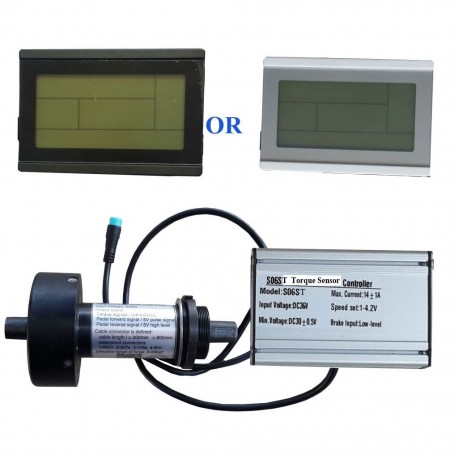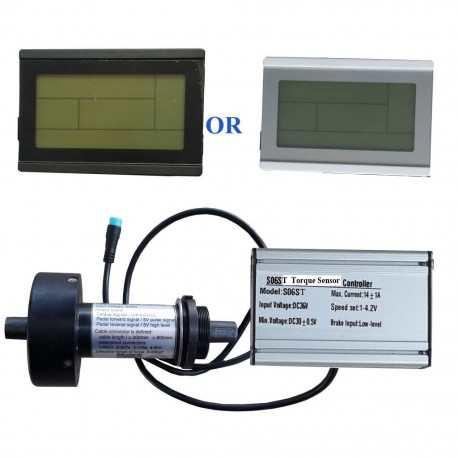What mid drive do you have? I'm not familiar with any of them that are compatible with a KT controller. Same story with the SW900 display? I'm not familiar with an SW900 that will work with a KT controller. KT controllers require a KT display......
Torque sensing bikes WILL add/subtract power depending on load and PAS level. PAS level sort of sets the upper limit available through the torque sensing. Lower PAS level = lower upper limit. Any setting alows the system to return to 0 when coasting.
A KT controller equipped bike is not torque sensing! They do not make a controller with the ability to read/have an input from a torque sensor.....
I'm left wondering if you have a KT controller? Model number on your controller is?
Finally got everything to work. I wanted to do a test ride up a 12% fire road near my home but decided to instead clear some overgrowth 20 minutes away by riding this offroad about 8 miles total. 50 lbs with front wheel/tire. Will try to trim closer to 45 lbs with different crankset later. Notes...

endless-sphere.com
The vast majority, like 95-99% of these online are sold as rear left-wheel bolt-on's, as in you take off the left brake rotor and bolt this on. Which is very lame, because you just lost your rear braking and now have to pray the chain will stay on between the rear wheel and motor mount with all the bumps that even a pavement bike has. The mid-drive version is the only way to go, although has other issues though (that I'll fix one at a time).
Besides PAS not working, the chain tensioner is very finicky and cheap. The motor chain has to be very lax or it will seize and literally pop right off the 42t chainring. That's another reason why I'm going to try and switch to a 3x Shimano hollowtech knockoff crankset for this, so I can use a real 104 BCD narrow wide chainring for the motor drive. And also a narrow wide for the middle chainring that's driving the rear cassette too. No front derailleur. The kit comes with FOUR chainrings, all steel and no this not a typo: they are all 64 BCD. Even the 42 and 44t ones. I have no clue why they made it like that. No conventional crank spider. Just a center bearing they drilled some 64 BCD holes into lol. That's called off-brand Chinese!!!
Now to answer your questions.
SW900 is on a different bike, a hub drive. I'm just comparing the throttle smoothness. I feel the 'imitation' torque on that controller is smoother for throttling while the KT is 100% for sure smoother for PAS.
The controller I'm using is KT 36/48 ZWSRM-ff01 12 mosfet. They last for a couple of years, couple thousand miles and then die. Most of my bike riding is with a normal acoustic bike, only use e-bike for screwing off or doing chores like trail work or dropping my car off for an oil change.
Neither of my two e-bikes have torque sensing. The KT has the imitation torque option, and I don't know what EBikeling calls it on SW900, but it works relatively better. Remember I'm typing the term imitation torque, not torque sensing

The power is added or subtracted for imitation torque to me based ironically on speed sensing. This terminology is going to get really confusing real fast. They should not call something either speed sensing or torque sensing, especially when there is no 'real' torque sensing. But when I'm going slower under otherwise CONSTANT throttle or PAS power (cannot emphasize the term constant enough), the controller knows it and ramps up power accordingly. That's really speed sensing power adjustment under what was constant power on a level surface. Elevation changes, controller senses speed change due to elevation change, power adjusted accordingly. Then when I'm at the top of the incline, the controller senses more speed and ramps down the power accordingly. Then when I'm back on a level surface the power goes back to constant. This happens with both SW900 and KT. It doesn't matter if SW900 doesn't have a 'term' for that, it still happens.
Here is your (AHicks) quote from a different site: "What it amounts to is a fixed amount of power supplied to the motor, which changes according to the PAS level, and speed no longer has any affect on what's going on (none!)."
Some comments on that sentence above. First, on this topic, for a KT controller everything revolves around the P3 and C4 parameters. Just my extremely humble opinion. See below.
P3 parameters affect the power assist control setting. When the value is set to 0, the throttle is dependent on the PAS Gear Ratio.
(what they call speed control) This means when the PAS gear ratio is 1, the throttle will provide the least amount of power, whereas when it is 5, the throttle will provide the most power. If the P3 parameter is set to 1, the throttle will provide the maximum power regardless on the PAS gear ratio chosen.
(what they call imitation torque)
So for 0 the throttle power is linked to the PAS 1-5 on the display. If I'm doing throttle only, I'll instead set P3 to 1, because throttle at least on a KT DOES NOT give the same range of power as when real PAS or pedal assist is active. It will fade. Even in PAS 4 there may not be enough power to get up the incline again with throttle only. In PAS 2-4 with real pedal assist there IS enough power to climb hills all day long, but not with throttle only. That's why I need to somehow find a way to get PAS back if using a KT controller. Throttle only has consistency/sensitivity problems.
C4 settings are for the handlebar functions. The setting range is 0-4. This is accompanied by a table below, defining each value.
(all of this below is non-zero startup only, where you don't need to pedal for the throttle to initiate power)
0 Zero startup handlebar Non-zero startup
1 Zero startup, throttle speed limited to 6km/h
2 Zero startup, throttle speed limited to rider's specification
3 Zero startup, zero gear effectively
4 Throttle gears is distinguished according to the display meter
I don't understand how they determined the speed limit for 2, but for me, if I'm throttling I would choose either 0 or 4 above, and then P3 as "1". "4" for C4 should be the same as P3 being set to "0".
P3 "0" and C4 "4" --- Both meter out five levels of throttle power through the display up and down button. As mentioned above, I don't like the throttle being tied to 5 levels of power because it's not the same level of consistent power compared with real pedal assist. It's just not, I can tell the difference. So I set it to max throttle power and thumb-adjust accordingly. If I can get PAS to work, remember without a freewheel, then I'd use a lower level of PAS with gentler surfaces and then ramp up any extra power I need through the throttle. Can't use PAS 4 or 5 if there is no freewheel because I don't know if I can stop the pedals from turning if there is 500+W turning fixed cranks/pedals.
So in my case I'd choose P3 "1" and C4 "0".
Not P3 "0" and C4 "4".
Here's the future of this motor for me personally:
1. Live with the crappy crankset because it can freewheel, and just throttle it.
2. Keep said mediocre crankset and switch to SW900 so the throttle is relatively smoother, but no PAS again. Because the EBikeling PAS is horrible IMO.
3. Even if I keep the crankset, eventually the rings will wear out, and then what am I gonna do? Buy 64 to 104 BCD adapters? This crankset is already wobbling after 20 miles. Some of the bolt holes have been manually drilled into a center bearing on the axle, how long are they going to last like that? Sooner or later I need a real crankset. The issue with that is that I'll lose the freewheeling and will have fixed chainrings and thus moving pedals whenever power is applied. The advantage is ironically enough that I'll be able to try a hollowtech-modified 2-piece PAS system. Sounds like an oxymoron, because hollowtech cranksets essentially have zero space between the external bearings and the crank pedals. In reality, the screw-on bearing cups are 10-15mm deep. So you can use a 3mm DIY motor bracket between the frame and external bearing, and on the right a 1-2mm PAS sensor next to it, then screw the drive side cap on firmly, everything should be OK. After all, people do that with shim spacers that come with the hollowtech bottom brackets to line up the pedals on each side of the frame. The only real issue is: can I shift like I normally do with a non-ebike, as in briefly stop pedaling, when in this case e-power is still turning the pedals!?! As in get the pedals to stop turning for 1/2 second while I shift? That will take some getting used to...





